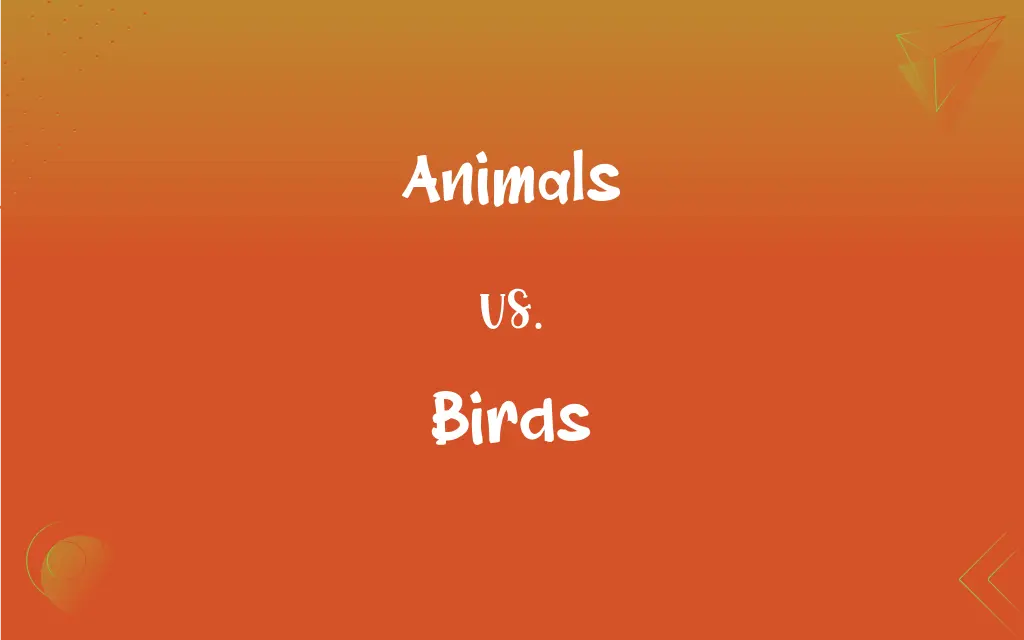Animals vs. Birds: What's the Difference?
Edited by Aimie Carlson || By Janet White || Published on February 27, 2024
Animals encompass all multicellular, eukaryotic organisms including mammals, reptiles, etc., while birds are a specific class of warm-blooded, feathered animals with wings.

Key Differences
Animals belong to the kingdom Animalia, encompassing a diverse range of multicellular organisms. Birds are a specific class (Aves) within this kingdom, characterized by feathers, beaks, and laying hard-shelled eggs.
Animals display a wide variety of physical forms, from fur-covered mammals to scaly reptiles. Birds, however, are defined by their feathers, wings, and lightweight skeletal structure.
Animals inhabit diverse environments, including land, sea, and air, adapting accordingly. Birds are primarily adapted for flight, although some are flightless, and are found in almost every habitat on Earth.
Reproductive methods among animals vary widely, including live birth and egg-laying. Birds exclusively lay eggs, with most species building nests for their eggs and young.
Animal behaviors and diets are incredibly diverse, ranging from carnivorous predators to herbivorous grazers. Birds’ diets and behaviors are varied but are adapted to their anatomy, like beak shape and wing design.
ADVERTISEMENT
Comparison Chart
Classification
Multicellular organisms in the kingdom Animalia.
A specific class within Animalia known for feathers and flight.
Physical Traits
Diverse forms including fur, scales, etc.
Characterized by feathers, beaks, and wings.
Habitat
Diverse habitats: land, water, air.
Adapted to aerial life, though found in varied environments.
Reproduction
Varies widely, from laying eggs to live births.
Exclusively lay eggs, often with nest-building.
Diet
Ranges from carnivorous to herbivorous.
Varied but adapted to flying lifestyle and anatomy.
ADVERTISEMENT
Animals and Birds Definitions
Animals
Organisms in the kingdom Animalia, known for their diverse forms and habitats.
The study of animals is a key part of biology.
Birds
Species known for laying hard-shelled eggs and building nests.
Robins skillfully build nests to protect their eggs.
Animals
Multicellular, eukaryotic organisms that are capable of movement.
Lions are one of the most majestic animals in the animal kingdom.
Birds
A class of warm-blooded vertebrates characterized by feathers and beaks.
Birds like eagles are admired for their powerful flight.
Animals
Beings that exhibit various forms of intelligence, social behavior, and survival strategies.
Octopuses are animals known for their remarkable intelligence.
Birds
Creatures with a unique respiratory system adapted for flight.
The respiratory system of birds is highly efficient, supporting their high-energy lifestyle.
Animals
Creatures that can range from microscopic to massive in size.
Blue whales are among the largest animals ever known.
Birds
Animals capable of flight, although some species are flightless.
Penguins are an example of flightless birds.
Animals
Species that reproduce either sexually or asexually.
Many animals have unique mating rituals and behaviors.
Birds
Animals with a diverse range of vocalizations and songs.
The songs of birds are often a symbol of natural beauty.
Animals
Any of numerous multicellular eukaryotic organisms of the kingdom Metazoa (or Animalia) that ingest food rather than manufacturing it themselves and are usually able to move about during at least part of their life cycle. Sponges, jellyfishes, flatworms, mollusks, arthropods, and vertebrates are animals.
Birds
Any of various warm-blooded egg-laying feathered vertebrates of the class Aves, having forelimbs modified to form wings.
FAQs
Can all animals move?
Most animals have some form of movement, though it varies widely across species.
Do animals have a common method of reproduction?
Animal reproduction methods vary, including sexual and asexual reproduction.
What is unique about bird reproduction?
Birds exclusively lay eggs and many species build nests for their eggs and young.
Do birds have a backbone?
Yes, all birds are vertebrates and have a backbone.
What is special about bird vocalizations?
Many bird species use complex songs and calls for communication and mating.
What defines an animal?
Animals are multicellular, eukaryotic organisms capable of movement and responsive to their environment.
What are birds classified as?
Birds are classified as a class (Aves) within the animal kingdom.
Can birds live in all types of environments?
Birds are found in almost every habitat on Earth, from deserts to polar regions.
What kinds of diets do animals have?
Animals have varied diets, from herbivorous and carnivorous to omnivorous.
Are all birds able to fly?
No, some bird species like ostriches and penguins are flightless.
Are all animals vertebrates?
No, many animals, like insects and mollusks, are invertebrates.
How do animals adapt to their environment?
Animals adapt through various means, including physical changes, behaviors, and social structures.
Can animals live in both water and land?
Some animals, like amphibians and certain reptiles, can live in both water and land.
How diverse are animal habitats?
Animal habitats are extremely diverse, ranging from deep oceans to high mountains.
Are birds considered intelligent?
Many bird species exhibit high levels of intelligence, problem-solving, and social behavior.
Are there aquatic birds?
Yes, many bird species, like ducks and penguins, are adapted to living in aquatic environments.
What do birds typically eat?
Bird diets vary greatly, including seeds, insects, fish, and nectar, depending on the species.
How do animals communicate?
Animals communicate in various ways, including sounds, gestures, and chemical signals.
Do all animals have brains?
Most animals have some form of a nervous system, but not all have well-developed brains.
What adaptations help birds in flight?
Birds have adaptations like lightweight bones, feathers, and wing structures for flight.
About Author
Written by
Janet WhiteJanet White has been an esteemed writer and blogger for Difference Wiki. Holding a Master's degree in Science and Medical Journalism from the prestigious Boston University, she has consistently demonstrated her expertise and passion for her field. When she's not immersed in her work, Janet relishes her time exercising, delving into a good book, and cherishing moments with friends and family.
Edited by
Aimie CarlsonAimie Carlson, holding a master's degree in English literature, is a fervent English language enthusiast. She lends her writing talents to Difference Wiki, a prominent website that specializes in comparisons, offering readers insightful analyses that both captivate and inform.































































